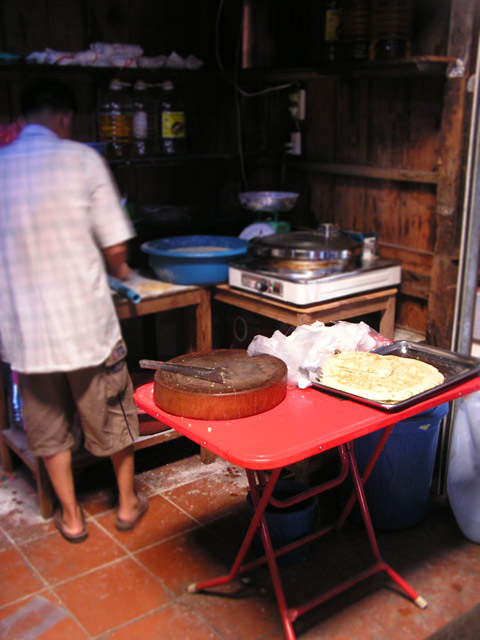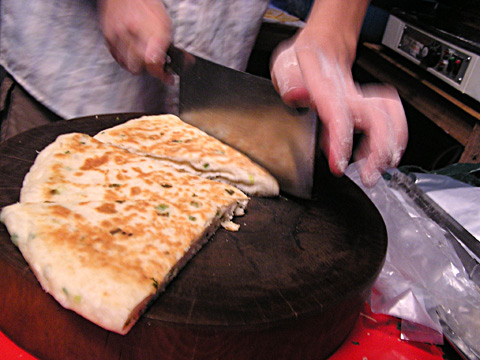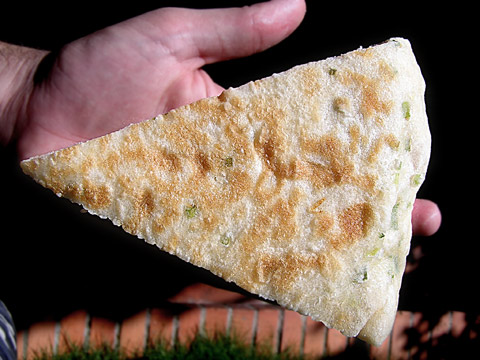Cambodian street food acts as an indicator of the global and historical tensions on modern Khmer culture. The pull between different cultural and historical influences is literally played out in the street food. It isn’t uncommon to see food that was transported to Cambodia about a millennium ago served next to food that first arrived a decade ago. Occasionally, like this flat bread, both the influences and timing are difficult to place.
I’ve heard this variously referred to as Chinese pizza or in Khmer, num pan chen (literally Chinese bread). My regular vendor at Psar Orussei has a sign that proclaims it “Stone Leek Bread”. It is certainly not a traditional Khmer recipe but seems to have come via China and capitalizes on one of France’s lasting colonial legacies in Cambodia: the ability to bake bread.
Where the Chinese version is simply fried, the vendors that I have seen around Phnom Penh simultaneously bake and fry the bread in a miniature commercial pizza oven. The dough proves in a plastic tub until a likely punter arrives, whence the vendor picks out a lump, adds a handful of chopped spring onions (scallions, for non-Commonwealth readers), gives it a quick knead and roll with a length of blue plumbing pipe and frys away.
Hot off the press, the bread is soft, elastic, and remarkably similar to good Turkish bread. It doesn’t keep particularly well but is so good that it is unlikely you’ll have leftovers.
500 riel (US$0.12) for an eighth of a pizza.
Location: The above vendor has only been open for a week at Stall 572, on the northern side of Psar Toul Tom Poung (Russian Market), amongst the motorcycle parts. There another talented spring onion bread baker near the southern entrance of Psar Orussei.
See also: A recipe for Spring Onion Bread mercilessly lifted from Bill Granger’s recipe book Bills: Breakfast, Lunch + Dinner



This is a northern china influence based on the famous northern chinese (I think Shanghai) spring onion pancake (I have no idea what the name is in Chinese)
Hey Maytel? Why for one time it could be Khmer influence in Northern china?
Ah Phil, I love this stuff, I often buy it when I am at O’Russi market, where several old women wander around selling it.
Yes, Jo and why can’t the baguette be a Khmer influence on the French?… oh that’s right because flour and flour products are not indigenous to Cambodia.
Maytel it was a joke, I think you have no sense of humour.
Maytel says: “This is a northern china influence based on the famous northern chinese (I think Shanghai) spring onion pancake (I have no idea what the name is in Chinese)”
I think you mean “cong you bing” (pinyin with tones: cÅng yóu bÇng; aka 葱油饼). Though I thought the dish was northwestern (rather than Shanghainese) in origin.
– Michael
I think it is different from a cong-you-bing, which is thinner and crispier, and doesn’t have so many layers, and is fried.
You see a baked, soft version like this in the Yangzi delta of China – Shanghai, Nanjing, etc. Definetly looks almost the same. Interesting how it was transplanted.
New York Hotel makes wonderful bread like this…